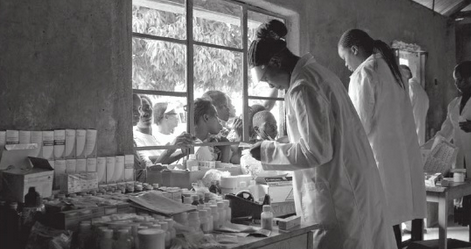Helena Scutt
Public health programs perpetually face the dilemma of balancing the allocation of limited financial resources between prevention and treatment. Present or future? Short-term or long-term? Although it is easy to glorify prevention, allocating resources to people who don’t yet have a given disease over current sufferers from that disease can be hard to justify.
“If you can make the investment and cover everyone, prevention is always a better investment and would likely save the most people,” said Dr. Eran Bendavid, a Research Associate at Center for Health Policy/Primary Care and Outcomes. “However, it is just not right to not treat people when you have treatment available. It’s just not right to deny treatment to that population.”
 HIV and malaria are two major diseases that lack a vaccine and whose prevention is largely a matter of behavior change. Examining the efforts against these diseases will provide insight into factors that cause the prevention and treatment balance to vary, as well as challenges of implementation, effective treatment and prevention strategies, and the significance of cost-benefit analysis.
HIV and malaria are two major diseases that lack a vaccine and whose prevention is largely a matter of behavior change. Examining the efforts against these diseases will provide insight into factors that cause the prevention and treatment balance to vary, as well as challenges of implementation, effective treatment and prevention strategies, and the significance of cost-benefit analysis.
Several factors influence prevention-treatment equations: cost of treatment, cost of prevention, disease prevalence, economic setting of afflicted areas, and the severity of the disease. “Much of it is about the burden, as in the number or percentage of people affected,” said Bendavid. “Political priorities also play a huge role.” Bendavid cites the South African government’s role in their revamped HIV policy as an example of this political effect.
Key points in this debate are that prevention is not always cheaper than treatment and the costs of prevention are challenging to measure. In addition, evaluating the success of a program is one of the greatest challenges and can often be unreliable.
“It’s hard to know when you’ve prevented something,” said Bendavid. “You don’t get credit for what hasn’t happened and you can’t prevent death; you can only delay it. In fact, preventing one disease can lead to more expenses down the road.” Thus, in some cases, preventive measures are more expensive than treatment.
Measures of prevention’s effectiveness can be challenging, as well. Dr. Darvin Scott Smith, Associate Clinical Adjunct Professor at the Stanford School of Medicine, points out, “With prevention, it’s hard to get measureable benefit and therefore hard to know its effectiveness.” This challenge in estimating effectiveness applies to national health policies as well as research. When a disease is being actively controlled, its incidence is low, and the importance of prevention programs is often forgotten in the public sphere.
For example, Zanzibar, an island state of Tanzania, had a highly successful malaria control program in the 1960s, but in 1968 it was forsaken because malaria was no longer considered a health problem.1 Consequently, the disease returned and, until recently, malaria remained Zanzibar’s number one public health problem.1
“Zanzibar wiped out malaria but is forced to continue to spend money on prevention efforts, specifically vector control,” said Smith. “As a major tourist destination, thousands of potential malaria-carrying people flow in every day. People no longer have immunity so an outbreak would be devastating.”
Since 2003, Zanzibar’s government has reduced parasite prevalence to below one percent. This effort has involved use of artemisinin-based combination therapies, indoor residual spraying programs, and insecticide-treated nets.1 Zanzibar must continue to allocate adequate funds to the prevention effort despite significantly reduced incidence levels of malaria and correspondingly decreased treatment costs.
In contrast to malaria’s prevention-dominated efforts, “most funding for HIV in the past decade has actually gone to treatment,” stated Bendavid. “HIV has seen enormous success in prevention, but with the rise of antiretroviral therapy (ART) and the lowering of its cost, the pendulum has swung toward treatment. With an infectious disease like HIV, if you treat it in one person, you prevent it in someone else.” Therefore, treatment becomes prevention, leading to therapies known as preventative treatments.
“You don’t necessarily have to pick one or the other,” said Dr. Yvonne Maldonado, Chief of the Division of Pediatric Infectious Diseases at the Stanford School of Medicine. “For example, preventing mother-to-child transmission (PMTCT) of HIV is a merge of prevention and treatment.”
For virtually all diseases, prevention must invariably be linked to early diagnosis and treatment. “In developed countries, HIV testing for pregnant women is mandatory, just like testing for Hepatitis B, syphilis, and rubella,” said Maldonado. “Even if tested at the time of delivery and labor you can still reduce HIV transmission risk by 90-98%. It’s a major investment because the cost of caring for babies with HIV is high.” Mother-to-child transmission is prevented by giving antiretroviral drugs to the mother before childbirth and small doses to the newborn for a short period after birth.
However, a promising plan is nothing without effective implementation. Although research and trials can improve our biomedical methods, the behavioral side of prevention is much harder to quantify and control. In the case of PMTCT, “we have the scientific answers. The tricky part is all in the implementation and maximizing cost-effectiveness,” explained Maldonado. “To maximize the effectiveness of prevention you have to build new programs around existing ones, such as integrate PMTCT into family planning.”
In designing the balance of prevention and treatment, the sustainability of the program and the structure of the existing public health system must be considered. A prevention-based strategy that cannot be upheld in the long-term is not effective.
Although treatment has received the most attention, prevention remains a vital component in controlling HIV. Countries in sub-Saharan Africa have launched HIV-prevention campaigns discouraging concurrency, or having two or more sexual partners. Estimating $1200–3800 as the lifetime medical cost of treatment for an HIV-infected individual in Africa, Bendavid used disease modeling to show that an anti-concurrency campaign costing about “$0.25 per person annually would need a program effectiveness of less than 5% in any of the study countries to be cost-saving.”2 Understanding the cost-effectiveness of prevention campaigns is key to justifying any spending on prevention over treatment.
As the examples of malaria and HIV show, the balance between prevention and treatment must be customized to both the disease and the targeted area. These efforts must take advantage of preventative treatment if possible and use surveillance to evaluate progress. Most importantly, the approach must integrate its efforts into the public’s consciousness and harness the power of behavior change—it must capture the hearts and minds of the affected population.
Dr. Darvin Scott Smith is Chief of Infectious Disease & Geographic Medicine at Kaiser Permanente. He currently teaches HUMBIO 153: Parasites and Pestilence: Infectious Public Health Challenges.
Dr. Eran Bendavid is the Assistant Professor of Medicine in the Division of General Medical Disciplines and Center for Health Policy/Primary Care and Outcomes Research Associate. He models diseases and studies the relationship between health policies and their outcomes, particularly HIV in Africa.
Dr. Yvonne Maldonado is a Professor of Pediatrics and Health Research and Policy and Chief of the Division of Pediatric Infectious Diseases at the Stanford School of Medicine. Much of her research has been focused on the prevention of perinatal HIV transmission. She is also a Berger-Raynolds Distinguished Fellow and Attending Physician at the Lucile Packard Children’s Hospital.
1. Africa Fighting Malaria. Keeping Malaria Out of Zanzibar. March 2008. Available at: http://www.fightingmalaria.org/pdfs/AFM_Zanzibar_March08.pdf. Accessed March 4, 2012.
2. Enns E.A., Brandeau M.L., Igeme T.K., and Bendavid E. Assessing effectiveness and cost-effectiveness of concurrency reduction for HIV prevention. Int J STD AIDS. October 2011;22(10):558-567.

